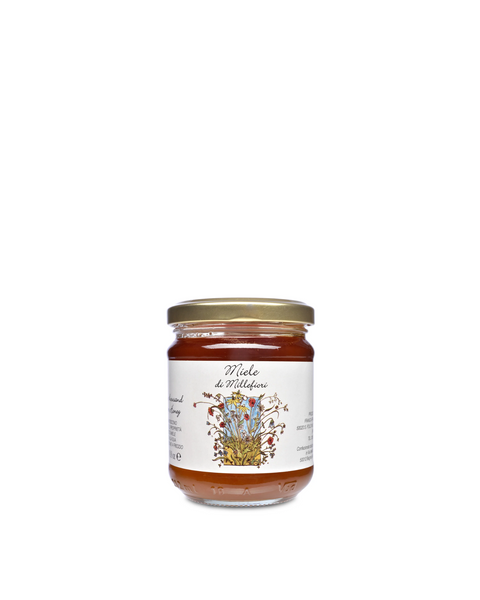
Millefiori Honey 8.8 Oz
“Milleflori” (thousand flowers) is also often called wildflower honey. This is both the most common type of honey and also, in a sense, the rarest: made of nectars from flowers in a particular place at a particular time, it is essentially impossible to reproduce its unique color, aroma and flavors from year to year. Simona, however, takes her bees to similar places that have a predominant mix of flora in order to produce a nectar of recognizable flavor.
This honey is complex and ephemeral, with strong aromatic elements of chesnut, dry herbs, and a long, rich sweet finish.
100% honey
The perfect honey for every use. Use as a table-top honey at the breakfast table, as well as in any recipe calling for honey.
In 2021, the incredible Franca Franzoni, our "Queen Bee," announced her retirement and passed the torch to her protégé Simona Pappalardo. Franca shared her passion for beekeeping and her knowledge of nature's ever-changing landscape of blooms with Simona, so that she can continue Franca's legacy in creating the incredible golden nectar we know as Franca's honey.
Franca's farm is near the village of Polo, located just south of Florence in the Chianti region. It is surrounded by fields of wild flowers, acacia and chestnut trees. Just like Franca, Simona considers herself a partner in the bee's efforts, aiding in the building of the hives, carefully planning the bee's foraging path and assuring production of a pure, clean artisan product.
The efforts start in the spring with the crafting of the beehives. Wax frames are carefully inserted into the hives for the worker bees to establish a home base. The purpose of the hive is to birth a new generation of bees by creating a place to incubate the young bee larvae. Once the base is set, a colony is introduced with the queen bee at the helm. The worker bees are sent to harvest nectar while the house bees set the stage for the incoming nectar and the introduction of the larvae by the queen.
Simona observes the worker bees' routine as they start to forage, monitoring the bees as they move from one bloom to the next. Worker bees hunt for nectar from blooms nearest to the hives. For optimal nectar collection, hives are placed near masses of blooms of the target sources, such as acacia or chestnut trees. On each trip from the hive the worker bee will gather twice its body weight in nectar. Depending on the bloom, the bees must visit between 100 and 1,500 blooms before being fully laden with nectar. Once laden, the worker bee returns to the hive. For a bee to collect enough nectar to produce one pound of honey, it will fly close to three trips around the world and visit approximately two million blooms.
Upon arrival back at the hive, the worker bee is met by a house bee and the nectar is transferred. The house bee introduces enzymes to start transforming the nectar into honey and then the nectar is deposited in the wax cells of the hive. The house bees fan the cells with their wings aiding in the evaporation of moisture from the nectar and keeping a constant ambient temperature (hence the humming sound from inside the hive).
Once the nectar has had the moisture reduced, it has a thick consistency and is sealed into the cells with a cap of wax, creating honeycomb. And from this point honey has been created and can be extracted from the comb. The honey laden frames are carefully removed from the hive. The wax cap is removed and the frames are placed by Franca vertically in the honey extractor. The tall round shape of the extractor allows the centrifuge process to force the honey to the walls where it falls into a collection vessel below. The honey settles for 20 days to mellow before packaging.
